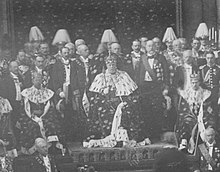This article needs additional citations for verification. (April 2011) |


Regalia (/rəˈɡeɪl.i.ə/ rə-GAYL-ee-ə) is the set of emblems, symbols, or paraphernalia indicative of royal status, as well as rights, prerogatives and privileges enjoyed by a sovereign, regardless of title. The word originally referred to the elaborate formal dress and accessories of a sovereign, but now it also refers to any type of elaborate formal dress. The word stems from the Latin substantivation of the adjective regalis, "regal", itself from rex, "king". It is sometimes used in the singular, regale.[note 1]


- ^ "The Royal Regalia". www.royalcourt.no. Retrieved 2024-07-31.
Cite error: There are <ref group=note> tags on this page, but the references will not show without a {{reflist|group=note}} template (see the help page).